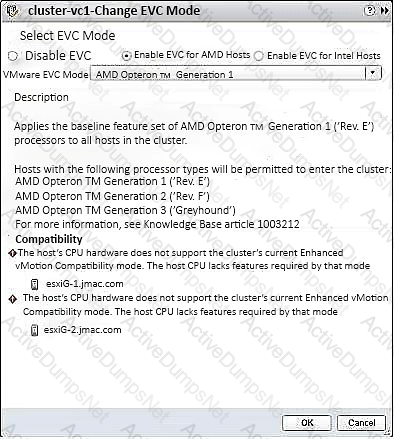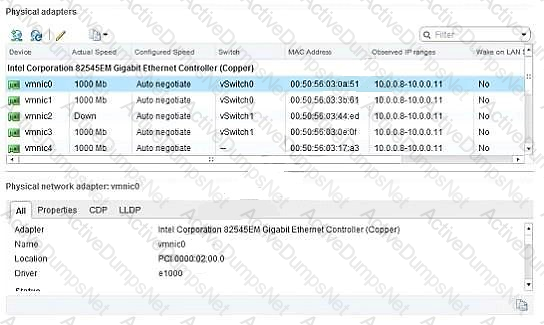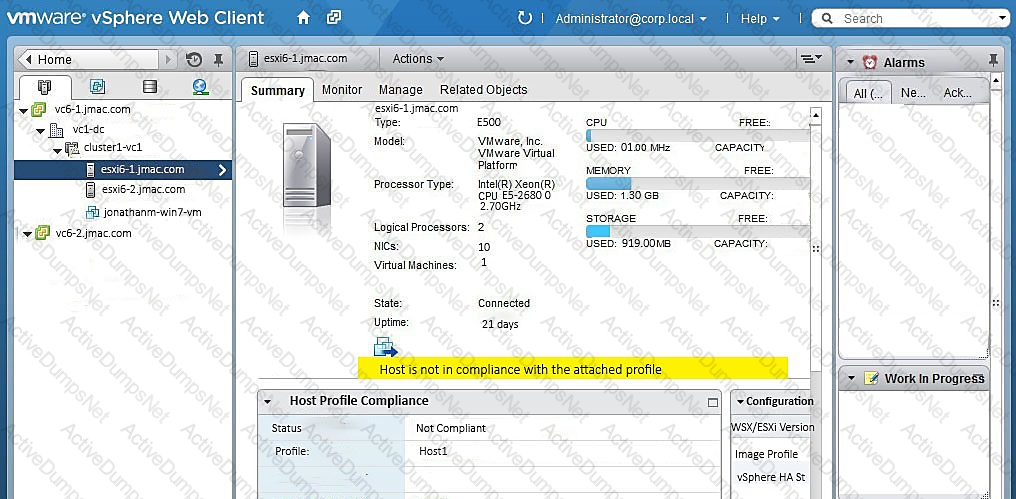Refer to the Exhibit. An administrator attempts to enable Enhanced vMotion Compatibility (EVC) on a cluster.
The operation results in a compatibility error, as shown in the exhibit.

What is the likely cause of this error?
An administrator receives a report that no real time statistics are available for a virtual machine in the vCenter Server inventory.
Which two statements indicate likely causes of the problem? (Choose two.)
After selecting an object in vRealize Operations, how can a user compare the badge values of related child objects?
A vSphere Administrator wants to enable Storage I/O Control. There is a mix of VMFS and NFS datastores. All of the VMFS datastores have hardware acceleration enabled. The Administrator attempts to create a new datastore cluster but is unable to add all of the datastores to the cluster.
What is the problem?
A virtual machine has been renamed and an administrator is unable to find files with the new virtual machine name in the datastore.
What is the reason for this?
An administrator creates an ESXi cluster using vSphere Auto Deploy.
The ESXi hosts are configured to get a management IP address from a DHCP server.
The administrator needs to troubleshoot the management network on one of the hosts.
Which DCUI option should the administrator use to renew the DHCP lease?
An administrator is configuring the Failover Order option on a vSphere Distributed Switch.
Which two options should be used with IP-hash load balancing? (Choose two.)
What is a benefit of using VMware Data Protection (VDP)?
You need to add an object to an existing vApp using the vSphere Web Client. How is this accomplished?
When configuring vSphere Replication for a virtual machine, what is the lowest Recovery Point Objective (RPO) that can be selected?
An administrator has unsuccessfully attempted several times to install an Operating System inside a virtual machine. The administrator finds that the installation fails at random intervals.
Which two actions can be taken to resolve this issue? (Choose two.)
Refer to the Exhibit. An administrator has configured network connectivity for a new virtual machine, as shown in the Exhibit.

What will occur with the network traffic of this virtual machine when communicating externally from vSwitch1?
An administrator is tasked with performing a vMotion migration of a virtual machine.
The virtual machine is configured as follows:
Which two statements are true? (Choose two.)
From which two locations in the inventory hierarchy can you deploy a virtual machine using a template? (Choose two.)
An administrator is re-provisioning an ESXi host and moving it to another datacenter.
Which DCUI option should the administrator use to revert the system configuration to the default settings?
Which two statements are true about VMFS5 datastores on ESXi 6.x? (Choose two.)
An administrator has just completed performing an interactive installation of ESXi 6.x and is booting the host.
How is the network initially configured?
A vSphere Administrator attempts to remove a host from a vSphere distributed switch, and fails. There is a notification that resources are still in use.
What are two possible causes? (Choose two.)
A mission-critical virtual machine built on vSphere 4.1 needs to be moved to an ESXi 6.x host.
Which virtual hardware version is needed to move the virtual machine without upgrading?
What two files are created when the Take snapshot operation is executed? (Choose two.)
What are two requirements for Guest Operating System Customizations? (Choose two.)
What are two requirements needed to enable a 4 vCPU virtual machine with Fault Tolerance? (Choose two.)
A vSphere Administrator notices that they cannot login to vCenter Server with the vSphere Web Client, although the server is responding to pings.
What is the next step in troubleshooting the login problem?
Which three options are available for remediation with Proactive HA? (Choose three.)
Which three actions are available in Troubleshooting Mode in the ESXi Direct Console User Interface (DCUI)? (Choose three.)
When managing search queries in vRealize Log Insight, what three actions can be performed? (Choose three.)
Which three virtual hardware configurations will allow snapshots? (Choose three.)
Which three options are available when applying a Customization Specification to an existing virtual machine? (Choose three.)
The Triggered Alarm on the VM shows Virtual Machine Consolidation needed status.
How would an administrator recover from this event?
Which two resource types can be limited on the vApp level? (Choose two.)
An Administrator would like to take advantage of the new Automatic UNMAP feature in VMFS6. All of the existing datastores are connected via iSCSI and formatted with VMFS5.
In order to minimize disruption and maintain some of the existing VMFS5 volumes, which two steps can be taken to leverage the UNMAP feature in VMFS6? (Choose two.)
Which option was added to the load balancing calculations of DRS in vSphere 6.5?
Which two statements are correct when licensing an ESXi 6.x host? (Choose two.)
Which file format supports the exchange of virtual appliances across products and platforms?
Which of the following are valid iSCSI adapter types for vSphere? (Choose three.)
A virtual machine loses network connectivity after vMotion.
Which two troubleshooting tasks can be performed? (Choose two.)
What two options are available when configuring a virtual flash resource on a virtual machine? (Choose two.)
What three steps are necessary to configure Virtual Volumes (vVOLs) on an ESXi hosts? (Choose three.)
Which two components can be used when configuring Enhanced Linked Mode? (Choose two.)
What may be a cause for failure to unmount an NFS datastore?
What is true regarding datastores on ESXi 6.x?
An administrator logs into the vSphere Web Client, but is unable to see any hosts and clusters.
Which two options could fix the problem? (Choose two.)
Which three VLAN Tagging modes are available in vSphere 6.x? (Choose three.)
Refer to the Exhibit. An administrator is configuring an ESXi 6.x host to use multiple NICs to resolve a management network redundancy error. After configuring a second NIC, the server is not able to communicate when the primary connection is taken down.
The administrator analyzes the Exhibit shown here.

Based on the exhibit, what is the likely cause of the issue?
An administrator has an application that requires connection directly to PCI devices through a virtual machine.
What is a limitation of this configuration?
Which three connection types are available when configuring a vSwitch in the vSphere Web Client? (Choose three.)
A vSphere Administrator currently has three two-socket servers that meet the requirements for VMware vSAN. Curently there is VMware Essentials Plus licensing for all servers. Implement a solution based on VMware vSAN?
What is the default load balancing policy for a newly created VMkernel port on a vSphere Distributed Switch?
VMware vSphere 6.x provides which three capabilities? (Choose three.)
An administrator is unable to remove an ESXi 6.x host from a vSphere Distributed Switch.
What are two likely reasons for this issue? (Choose two.)
An administrator is creating a new vSphere Distributed Switch that will be utilized with a specific vSphere Cluster. The cluster itself contains a mix of ESXi 5.x and 6.x Hosts.
Which Distributed Switch version should be created to support this configuration?
Refer to the Exhibit. An administrator logs into the vSphere Web Client and sees the warning shown in the Exhibit.

During a change control window, the warning was addressed.
What should be done to verify that the host is no longer showing the warning?
Which two locations are supported for an ESXi installation script to reside on? (Choose two.)
An administrator is attempting to enable Storage I/O Control on a datastore, but it is failing.
What is the likely reason for this failure?
Which two options are valid to create vApp in the vSphere Environment? (Choose two.)
Which three statements are true regarding Fault Tolerance? (Choose three.)
Which template captures the state of a vSphere virtual machine or vApp into a self-contained package and compresses the disk files in the sparse format?